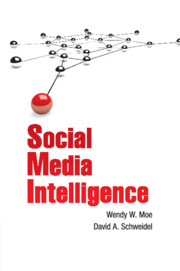1 - The Beginnings of Social Media Intelligence
from Part I - Foundations
Published online by Cambridge University Press: 05 February 2014
Summary
Let’s say you just had a great dining experience at a new restaurant that opened down the street. Or you just saw the worst movie of your life. Many people with these experiences turn to social media to talk about their experiences and share their opinions (we discuss why people do this in Chapters 2–4). Some may write a lengthy review on their blog. Others may write shorter reviews and post to a review site (like Yelp or Rotten Tomatoes). And still others may choose to engage in a lengthy back-and-forth discussion about the merits and pitfalls of the experience in an online discussion forum.
Expressing opinions in this way is not new behavior. In the past, we referred to this as word-of-mouth behavior. Neighbors talking to neighbors about their new cars. Co-workers having conversations around the water cooler about a new computer or the latest events unfolding in their favorite television programs. But there are two fundamental differences between offline word-of-mouth activity and online conversations occurring in social media.
- Type
- Chapter
- Information
- Social Media Intelligence , pp. 3 - 17Publisher: Cambridge University PressPrint publication year: 2014



